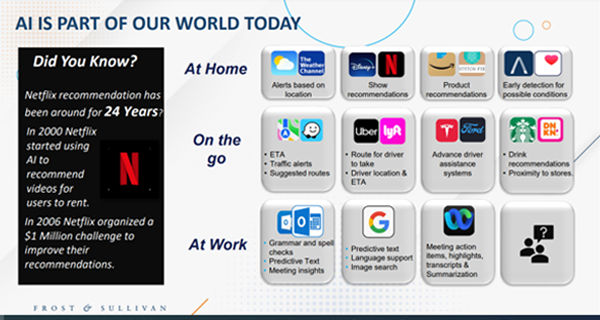Insights from a Virtual Event moderated by Aini Ali
Customer Engagement Leadership Council member Aini Ali recently led a virtual member event on the topic of Leveraging Evolving Technologies. Read on for some of the key insights and discussion takeaways shared, designed to help you navigate your organization’s technology strategy and planning. Click here for more information about council membership.
Abstract
How can we best leverage evolving technologies to improve operations and ultimately, the client and associate experience? Customers are demanding more from our contact centers. It is crucial to find a modern and secure solution along with strategic initiatives to meet their needs. In this session, Council Member Aini Ali shared a few areas of focus to help lower costs, recover faster, and deliver optimization.
Areas of focus
- Integrating multiple platforms and channels to deliver a seamless CX
- Optimizing automation, AI, and ChatGPT: Best bang for the buck
- Employing strategies to simplify the agent desktop and minimize customer friction
Aini opened the Virtual Event with a timely question for attending members: Where are you on your AI journey now? Highlights of their replies are summarized below:
- We’re using AI to audit approximately 80% of our phone calls. It’s made a huge difference…we get results and insights the next day.
- We have an innovation group that formed an AI committee with stakeholders across the organization. They are examining how to use AI for strategy, where to start, and where to keep going.
- We’re just getting started on our journey with AI. We want to apply it to automations, scripting and more effectively leveraging data. We’re seeking to understand behaviors with ChatGPT.
- We’re in the early stages of our AI journey…using it in post-call summary notes, for knowledge management and searching capabilities.
- We’re looking at cloud-based contact center solutions. Currently using RPA for outbound calls.
- We’re treading carefully with AI – in early stages. We’re defining standards and guidelines and teaching employees. Need to be careful it’s not being shared outside the company. We’re also using RPA.
- We’re using auto complete with live chat. Rolled out voice verification with Generative AI. Rolling out a Virtual Assistant enabled by AI. For 2025, we’ll be looking at sentiment analysis and automated quality management. We’re looking to increase accuracy.
AI is not new
Noting the members’ different AI journeys, Aini reminded the group that AI has been used for years in various ways at home, at work and for travel. Popular applications, highlighted in the graphic below, include AI powering maps for directions or apps for weather predictions. At work, AI has been used for grammar and spell checking and meeting summaries. Of course, the advent of ChatGPT is now taking applications and usage to a whole new level, especially in the workplace.

Aini offered guidance on building out use cases for AI applications in contact centers. She encouraged members to determine which (customer) service channel in their organization would benefit most from AI. Key considerations include:
- What channels does my organization have?
- What channel(s) have the heaviest volume?
- Can I segment and test capabilities?
- What are the top friction points for my customers?
- What do I want to measure?
As noted, chat functions are often a starting point for AI applications. Enterprises program chat bots with AI, analyze results and then fine tune the capabilities based on results and insights. Generative AI can automate these actions and help companies tweak the process, too.
The importance of a consolidated database to underpin AI was emphasized. As often noted, AI is only as good as the data that supports it. All departments need to be working from the same centralized data. Technology issues such as migrating older systems, transitioning to cloud platforms, and leveraging a microservices approach, were also discussed.
Managing change
As most are aware, AI exploded onto the business landscape and global stage in 2023. Many enterprises are currently in the throes of seeking to fully understand AI and its capabilities, and deciding when, how and where to use it. A key part of this process will include the education of both leaders and employees; all must understand AI and the changes it can bring to implement it wisely and effectively. As shared, many job functions and processes will be affected, requiring organizations to put procedures and guardrails in place to ensure best practices. Human oversight is crucial.
Using Generative AI for calls
Aini shared that her organization, ADP, was using AI to help wrap up and automate some parts of their customer calls, eradicating the need for associates to write call summaries for these interactions. The process of implementing AI for this use included a four-month pilot; it took time to train the AI algorithm. ADP had approximately one hundred associates test it and provide feedback.
A key takeaway: before using AI, the process of receiving, (via surveys, etc.) analyzing and acting on customer feedback typically took three to five weeks. With AI, the entire process, from receiving information to reviewing, analyzing, and acting on it happens in two to three hours or less!
AI in the contact center – what’s next?
Looking ahead, AI will likely be used for guided workflows (simplifying the agent experience) or to highlight the latest trending customer issues in CRM systems. AI can be used to help agents be more proactive, by “pushing” relevant information to them in the moment and showing previous customer interactions. Importantly, it can signal when the data shows a customer is at risk. Finally, AI can help organizations leverage massive volumes of data for better, more efficient customer service. These impressive capabilities augur new experiences for customers and more advanced job profiles for agents.



